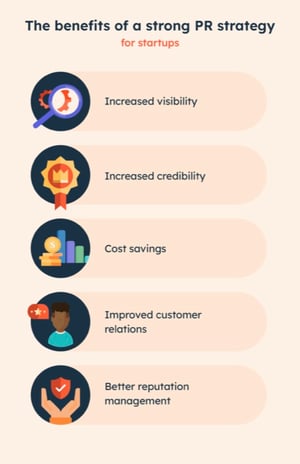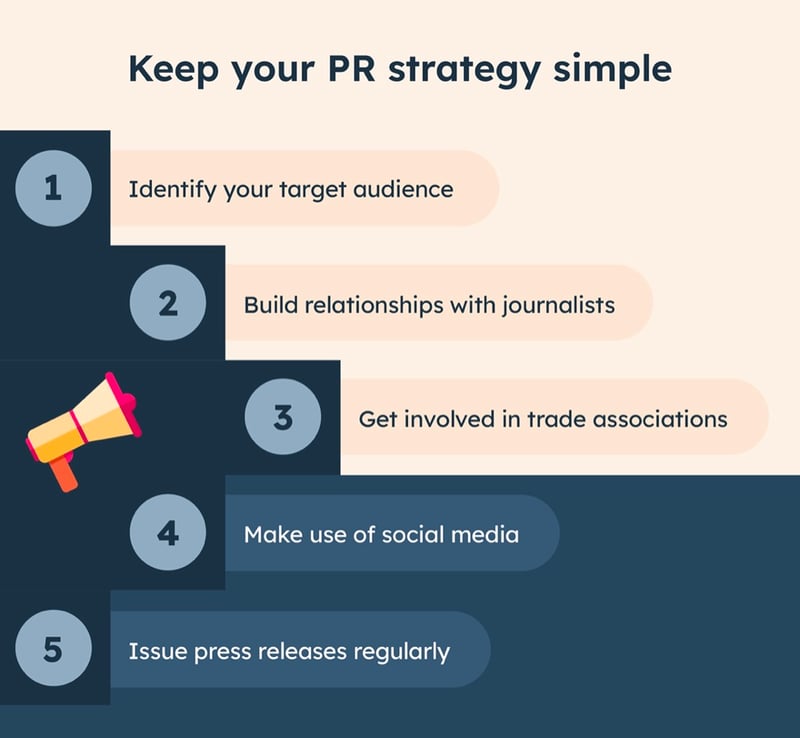While big businesses and celebrities use PR teams to manage the rumor mill and craft positive perceptions about their brands, startups can also benefit from a public relations strategy.

A good PR strategy for startups can help raise brand awareness, reach wider audiences, and even boost conversion rates. Rather than focusing so much of the budget on advertising, PR for startups can help increase conversion rates up to 50 times compared to ads.
Table of Contents
What is PR?
PR, or public relations, is how companies communicate their brands, missions, products, and important news to the public.
When a brand crafts a PR strategy, it is determining how it will present itself to the public and, ideally, influence people to perceive the brand and its products positively.
Why PR for startups is important
 Whether a 100-year-old company wants consumers to welcome an updated brand logo or a new business wants to spread the word about its products, communicating these messages via a PR strategy will get the job done.
Whether a 100-year-old company wants consumers to welcome an updated brand logo or a new business wants to spread the word about its products, communicating these messages via a PR strategy will get the job done.
Around 87% of consumers start searching for products online. If your startup is showing up as a top news article or your brand is getting social media buzz thanks to your PR tactics, you’re more likely to reach these consumers.
From time to time, brands can also experience setbacks, rumors, or other negative attention. A quick, effective PR strategy can help minimize negative perceptions or quickly put false rumors to rest.
Should you DIY or hire a PR firm?
Startups often have tight budgets. So should you hire a PR firm, or handle these tasks on your own?
PR agencies often have media connections — and proven success in gaining attention for brands — so it could be a worthwhile investment for your business..
However, if your budget doesn’t have room to hire an agency, then try to find the time to do the research and work on a PR strategy yourself.
Types of PR tactics for startups
There are several different avenues for startups to consider when building a PR strategy. You might want to attend events to network and spread the word about your business, or you could aim to go viral on social media.
Ideally, your PR strategy will involve multiple tactics, to keep people interested in your startup in fast-evolving media cycles.
Business events
Attending business events can be an invaluable way to get the word out about your company. Although much of business PR and marketing is going online, don’t discount how impactful attending events like industry conferences and trade fairs can be, especially for events that can gain media attention.
Community relations
Consumers are up to six times more likely to support purpose-driven companies. One way to give more purpose to your company — and give back to your local community — is to improve community relations.
Companies could donate portions of proceeds to local causes or participate in charity events.
Even offering special perks, like discounts, to those in your community can boost consumers’ feelings toward a local startup.
Corporate responsibility
From providing fair wages and working conditions to focusing on sustainable, eco-friendly operations, brands that incorporate corporate responsibility into their PR strategy can improve public perception.
The results are clear: 77% of consumers want to purchase from companies that are working to make the world a better place.
Crisis management
Crises come up for businesses all the time. You could have a product recall or a negative review of your brand making waves on social media.
Consider crisis management when developing a PR strategy. Monitor for disruptions to catch and resolve them early, to minimize or reverse negative public perception.
Media relations
One of the most important components of PR for startups is developing connections with media professionals like journalists. These pros hold the key to top media placements for your brand.
With strong media relations, you can get news out about your brand and products for free.
Social media
One in three consumers prefer to learn about brands through social media. Effective campaigns on top social media platforms are a surefire way to reach wider audiences.
You can create posts on your company’s account and interact with followers. You could pay to boost your posts. You could also work with influencers to promote your products, or your company could simply go viral organically.
No matter the method, maintaining a fun, positive online presence is another important facet of a strong PR strategy.
How to create an effective PR strategy for startups
Whether you want to spread word about your brand or showcase your hero product, consider these steps when crafting a PR strategy for your startup.

Define your brand’s story
Public relations is all about storytelling. More than half of customers in a survey said they would purchase goods or services from a business if they like the brand’s story.
Use your company’s story to connect to audiences. Be transparent and vulnerable. What inspired the founder to start the company? What problems are you hoping to solve for others?
Set goals
What are you hoping to achieve with your PR strategy? For many startups, getting a positive word out about their brand is a top priority. Or you may want to highlight a premium product or a unique service.
To get started, write down your top goals, then rank goals by priority.
Brainstorm newsworthy elements
For startups especially, finding newsworthy, unique elements that make your company stand out from the crowd is critical to crafting attention-grabbing press releases.
This information will connect to your brand’s value proposition, or the innovative features that make the company different from its competitors.
Nail down themes and a quick pitch
Once you brainstorm with your team or an outside PR firm, you can review the ideas and identify any themes, such as promoting a specific product or highlighting a new sale promotion.
For each of the strongest themes and ideas, pull together a quick, one-sentence pitch, which you can use when connecting with media professionals to quickly describe your brand.
Create a timeline
Every strategy needs a timeline, so you can test different campaigns and track success. Because news moves swiftly, you’ll want to plan a PR campaign about once every month, especially as you are starting out.
Build a campaign
With a specific goal and timeline in mind, you can begin planning out the campaign. This may involve designing graphics to post on social media, writing press releases to send to journalists, or scheduling interviews with reporters.
Network with media professionals
You can write a beautifully crafted press release, but it won’t do much good if journalists don’t include your information in a story. Writers and editors receive 24 to 53 PR pitches a day on average, making it daunting to compete for their attention.
The key is to make network connections and craft personalized pitches to each journalist or editor. One survey found that 64% of journalists believe it is important for those working on a PR strategy to establish personal connections before sending pitches.
Utilize social media
Take your story to top social media platforms to gain more attention. Make sure to handle negative online attention as well through crisis management tactics.
You may also speak to your media contacts — maybe you could set up live interviews for social media platforms to get the word out about your brand, or you could let an influencer take over your brand’s social media for the day to reach new followers.
Analyze campaign success
As the campaign nears its end, check on the results to see how your PR tactics impacted your brand.
Check to see if certain media placements had more impact than others, and which messaging resonated most with audiences. Use this data to tailor your next campaign and focus your efforts where they are most meaningful.
Metrics to determine success of a PR strategy
Utilize metrics to evaluate the effectiveness of your PR campaigns and long-term strategies. Because PR efforts create more indirect impacts on sales, it’s not always clear at a glance whether the tactics are working.
However, there are several metrics for public relations:
Share of voice
How does your brand stack up against the competition? Use share of voice to find out.
Input a metric, like your brand’s mentions on a specific social media platform. Add that to the brand mentions of your competitors to get a total. Divide the first metric for just your brand by total market measures to find your startup’s percentage share of voice. You can check to see if your share of voice increases amid a PR campaign.
One thing to keep in mind: not all mentions are positive. Read or listen to what people are saying about your brand online. If you’re seeing a lot of negative coverage, tap into your PR tactics to improve your reputation.
Pitch interactions
You’ve spent all that time building connections with journalists, writing press releases, and pitching to your network. So how successful were those efforts?
Make sure to track how many pitches you’ve sent, how many pitches received responses, and how many pitches ultimately earned media placement.
Social media engagement
Are people interacting with your content and sharing it with their own followers? Look into your engagement numbers for metrics including likes, shares, comments, or reactions to get an idea of how people interact with your brand online.
Social sharing is especially important, because this type of engagement is the biggest vote of confidence your followers are giving your brand.
Online traffic
Once word is out about your brand, you can check your web traffic to see if numbers are increasing.
Maybe a major news outlet linked to your website in an article, or a successful social media post sent followers to click on your “link in bio.” Look at web traffic and where the traffic is coming from, to determine any potential connections to your PR tactics.
Startups shouldn’t underestimate the value of a well-planned public relations strategy. A good PR strategy can lead to reaching new audiences, gaining attention of potential investors, boosting lead generation, and even increasing sales.

.png)
%20(1)-2.jpg)




%20(1).jpg)


-1.png)